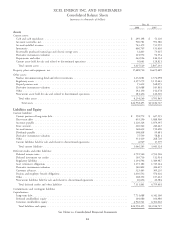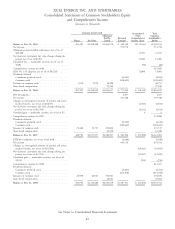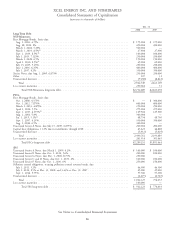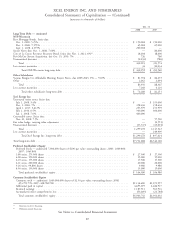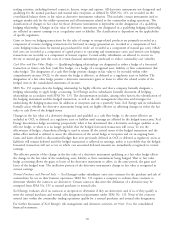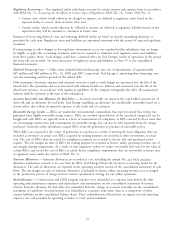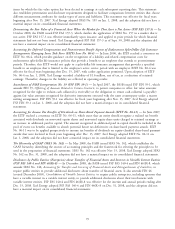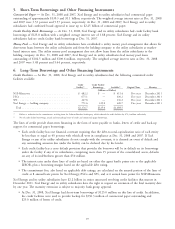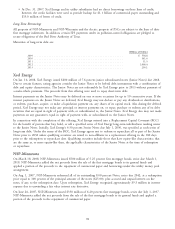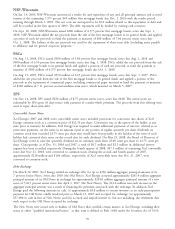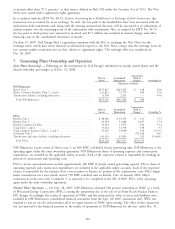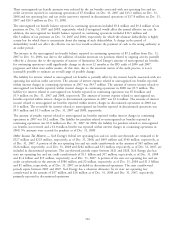Xcel Energy 2008 Annual Report Download - page 103
Download and view the complete annual report
Please find page 103 of the 2008 Xcel Energy annual report below. You can navigate through the pages in the report by either clicking on the pages listed below, or by using the keyword search tool below to find specific information within the annual report.Regulatory Accounting — Our regulated utility subsidiaries account for certain income and expense items in accordance
with SFAS No. 71, Accounting for the Effects of Certain Types of Regulation (SFAS No. 71). Under SFAS No. 71:
• Certain costs, which would otherwise be charged to expense, are deferred as regulatory assets based on the
expected ability to recover them in future rates; and
• Certain credits, which would otherwise be reflected as income, are deferred as regulatory liabilities based on the
expectation they will be returned to customers in future rates.
Estimates of recovering deferred costs and returning deferred credits are based on specific ratemaking decisions or
precedent for each item. Regulatory assets and liabilities are amortized consistent with the period of expected regulatory
treatment.
If restructuring or other changes in the regulatory environment occur, our regulated utility subsidiaries may no longer
be eligible to apply this accounting treatment, and may be required to eliminate such regulatory assets and liabilities
from their balance sheets. Such changes could have a material effect on Xcel Energy’s results of operations in the period
the write-offs are recorded. See more discussion of regulatory assets and liabilities at Note 19 to the consolidated
financial statements.
Deferred Financing Costs — Other assets included deferred financing costs, net of amortization, of approximately
$69 million and $48 million at Dec. 31, 2008 and 2007, respectively. Xcel Energy is amortizing these financing costs
over the remaining maturity periods of the related debt.
Debt premiums, discounts, expenses and amounts received or paid to settle hedges are amortized over the life of the
related debt. The premiums and costs associated with refinanced debt are deferred and amortized over the life of the
related new issuance, in accordance with regulatory guidelines. If the company extinguishes the debt, all unamortized
balances shall be expensed at the time of the redemption.
Accounts Receivable and Allowance for Bad Debts — Accounts receivable are stated at the actual billed amount net of
write-offs and an allowance for bad debts. Xcel Energy establishes an allowance for uncollectible receivables based on a
reserve policy that reflects its expected exposure to the credit risk of customers.
Renewable Energy Credits — RECs are marketable environmental commodities that represent proof that energy was
generated from eligible renewable energy sources. RECs are awarded upon delivery of the associated energy and can be
bought and sold. RECs are typically used as a form of measurement of compliance to RPSs enacted by those states that
are encouraging construction and consumption of renewable energy, but can also be sold separately from the energy
produced. Currently, utility subsidiaries acquire RECs from the generation or purchase of renewable power.
When RECs are acquired in the course of generation or purchase as a result of meeting the load obligation, they are
recorded as inventory at actual cost. RECs acquired for trading purposes are recorded as other investments at actual
cost. The cost of RECs that are retired for compliance purposes are recorded as electric fuel and purchased power
expense. The net margin on sales of RECs for trading purposes is recorded as electric utility operating revenues, net of
any margin sharing requirements. As a result of state regulatory orders, we reduce recoverable fuel costs for the value of
certain RECs and record the cost of RECs to satisfy future compliance requirements that are recoverable in future rates
as regulatory assets under the criteria of SFAS No. 71.
Emission Allowances — Emission allowances are recorded at cost, including the annual SO2 and NOx emission
allowance entitlement received at no cost from the EPA. Xcel Energy follows the inventory accounting model for all
allowances. The sales of allowances are reported in the operating activities section of the consolidated statements of cash
flows. The net margin on sales of emission allowances is included in electric utility operating revenues as it is integral
to the production process of energy and our revenue optimization strategy for our utility operations.
Reclassifications — Conservation and DSM program expenses were reclassified as a separate item from both other
operating and maintenance expenses and depreciation and amortization on the consolidated statements of income.
Activity from the allowance for bad debts was reclassified from the change in accounts receivable on the consolidated
statements of cash flows. Accrued interest was reclassified as a separate item rather than as a component of other
current liabilities on the consolidated balance sheets. These reclassifications did not have an impact on total operating
expenses, net cash provided by operating activities or total current liabilities.
93



